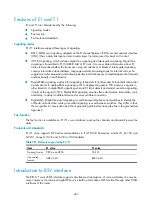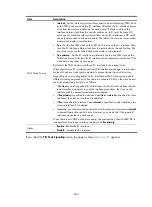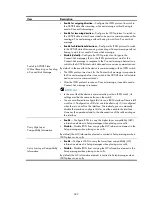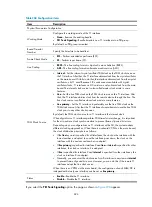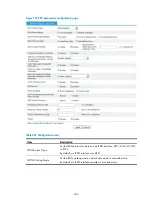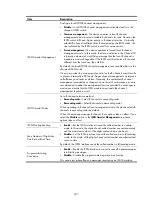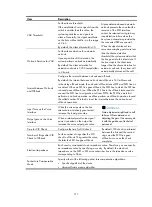
700
Item Description
ISDN Call Reference Length
Set length of the call reference used when a call is placed on an ISDN
interface.
The call reference is equal to the sequence number that the protocol assigns to
each call. It is 1 or 2 bytes in length and can be used cyclically.
When the device receives a call from a remote device, it can automatically
identify the length of the call reference. However, some devices on the
network do not have this capability. In the event that the device is required to
place calls to such a device connected to it, you must configure the device to
use the same call reference length configured on the connected device.
Status
Enable
—Enable the BSV interface.
Disable
—Disable the BSV interface.
Displaying ISDN link state
Select
Voice Management
>
Digital Link Management
from the navigation tree, and then click the name
of the target digital link (taking a VE1 digital link as an example) to access the page displaying the link
state as shown in
Figure 722
Displaying ISDN link state
E1 voice DSS1 signaling configuration example
Network requirements
As shown in
, Telephones in City A and City B communicate with each other through Router
A and Router B over an IP network.
•
Router A is connected to a PBX through an E1 voice subscriber line, and to the telephone at
0101003 through an FXS voice subscriber line.
•
Router B is connected only to a PBX through an E1 voice subscriber line.
The two routers communicate with their respective PBX by exchanging DSS1 user signaling through an
ISDN interface. The one-stage dialing mode is configured on the two routers.
Summary of Contents for MSR SERIES
Page 17: ...xv Documents 835 Websites 835 Conventions 836 Index 838 ...
Page 20: ...3 Figure 3 Initial page of the Web interface ...
Page 42: ...25 Figure 13 Firefox Web browser setting ...
Page 59: ...42 Figure 27 Checking the basic service configuration ...
Page 73: ...56 Figure 35 Sample interface statistics ...
Page 156: ...139 Figure 139 Rebooting the 3G modem ...
Page 168: ...151 Figure 152 Configuring Web server 2 ...
Page 174: ...157 Figure 158 Configure the URL filtering function ...
Page 242: ...225 Figure 233 Enabling the DHCP client on interface Ethernet 0 1 ...
Page 247: ...230 Figure 236 The page for configuring an advanced IPv4 ACL ...
Page 255: ...238 Figure 241 Advanced limit setting ...
Page 298: ...281 e Click Apply 2 Configure Router B in the same way Router A is configured ...
Page 400: ...383 Figure 387 Verifying the configuration ...
Page 405: ...388 ...
Page 523: ...506 Figure 530 Ping configuration page ...
Page 775: ...758 Figure 785 Configuring a jump node ...


